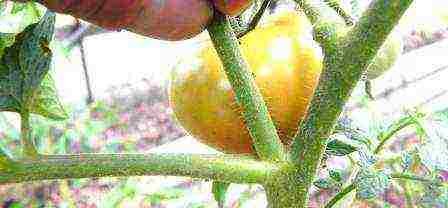Content
- 1 Kiwi at home
- 2 Planting and transplanting procedure
- 3 How to plant a kiwi stalk
- 4 Pruning guidelines
- 5 Other important nuances of caring for a vine
- 6 Diseases and pests threatening kiwi
- 7 Reviews about growing kiwi
- 8 Basic requirements for growing
- 9 Kiwi - growing at home
- 10 Features of vegetative reproduction of kiwi
- 11 How to get a big harvest?
- 12 How soon after planting a kiwi to wait for the fruit to appear?
- 13 Does the kiwi need extra watering?
- 14 Fertilizers for kiwi. Pest control
Lemons and oranges grown on the windowsill have long been a surprise. Therefore, amateur flower growers are constantly trying to "domesticate" new crops. You can grow "in captivity" and kiwi. If you set a goal, from seeds in a few years you can get stably fruiting plants.
Kiwi at home
In nature, the kiwi (the plant is known to botanists under the name actinidia chinensis) is a tree-like vine that prefers a tropical or subtropical climate. At the tops of the shoots, whole clusters of large fruits ripen, in appearance similar to very large gooseberries. Depending on the type, they can be smooth or rough to the touch.
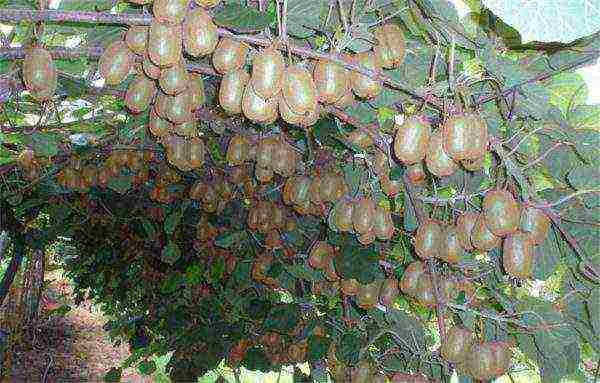
In nature, the kiwi vine reaches 7-10 m in length
In principle, there is nothing difficult in creating a microclimate for kiwi that is close to optimal. But the plant is classified as dioecious. This means that for fruiting, it is necessary to have at least two specimens - male and female. You can distinguish them only during flowering. The former, acting as pollinators, lack a pistil, but there are many stamens. One male plant is enough to pollinate five to six females. Jenny is the only self-pollinated kiwi in existence. But even in this variety, the presence of a number of male plants has a positive effect on productivity.
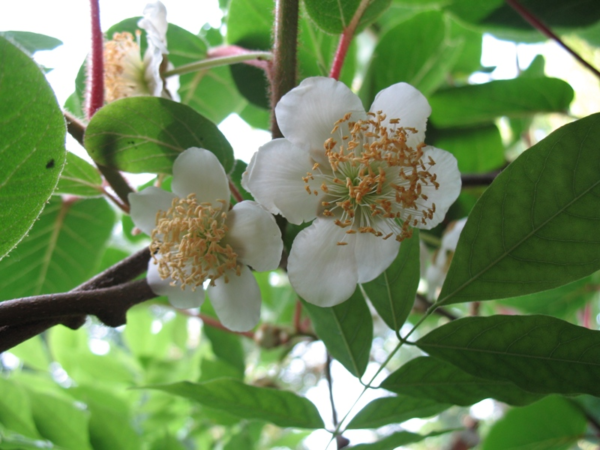
The presence of a male plant is useful even if the variety is self-pollinated.
Video: how to determine the gender of a kiwi plant
Kiwi flower growers are valued not only for fruiting, but also for flowering, long and abundant. Large five- or six-petalled flowers gradually change color from snow-white to yellowish-cream, lemon or lime.
Fruits at home, as a rule, ripen less than the description of a particular kiwi variety promises. But in terms of the content of vitamins, macro- and microelements, taste, they are in no way inferior to those grown in the open air. Ripe fruits are easily separated from the vine. They are stored in the refrigerator, the approximate "shelf life" is one and a half to two weeks.
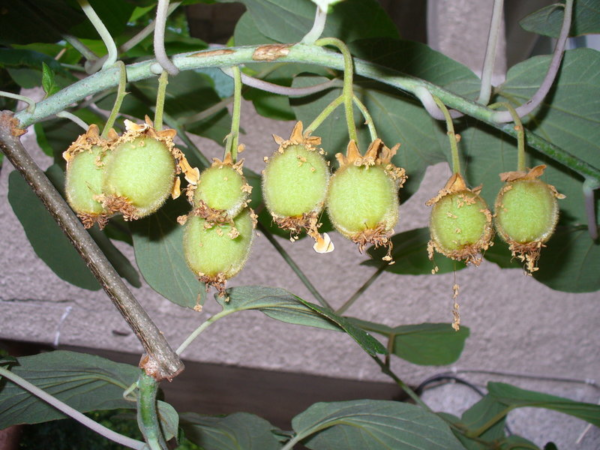
Homemade kiwis are small, but very tasty
There are no problems with obtaining kiwi seeds at home. They can be taken from any store purchased berry. But seedlings grown in this way very rarely inherit the varietal characteristics of the "parent", and the palatability of the fruit leaves much to be desired. Therefore, they are most often used as a rootstock, and any seedling of a certain variety purchased in a specialized nursery acts as a scion.
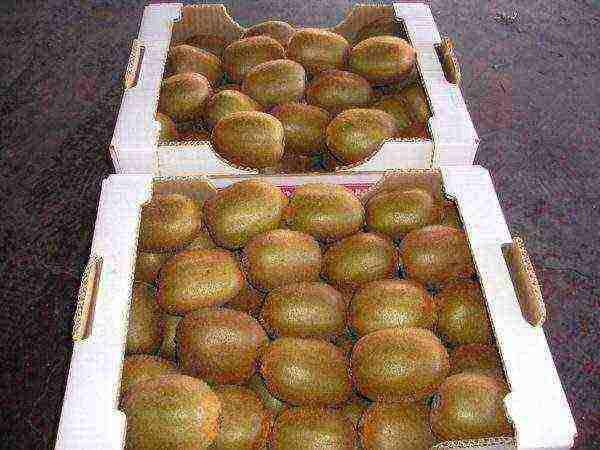
Viable seeds can be obtained from the kiwi fruit, which can be purchased at any grocery store
Harvesting from seed-grown kiwis will take a long time. As a rule, such plants bloom for the first time not earlier than six years after planting.

It is desirable to obtain planting material from mature and healthy-looking fruits.
For the correct development of kiwi, warmth and sunlight are vital. Therefore, the pot is placed in the brightest place in the apartment, for example, on the southern or southwestern windowsill, periodically (every 2–2.5 weeks) turning it so that the heat is evenly distributed. Cold drafts are categorically contraindicated. Regular feeding (preferably organic) and proper watering are equally important.
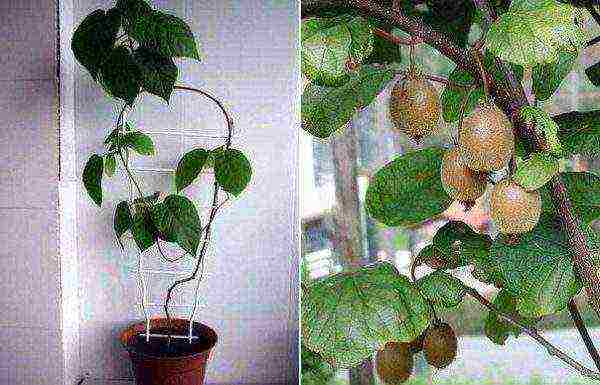
In nature, kiwi is a liana, so you need to take care of the support for it in advance.
For some reason, actinidia juice has an effect on cats (and, to a lesser extent, on cats), similar to that of valerian tincture. Therefore, it is worth removing the pot where the cats will definitely not get to it, or surround the plant with a net.

Cats do not eat kiwi leaves and shoots, but they can severely damage the plant, trying to get to the juice, to which for some reason they are very partial
Planting and transplanting procedure
Kiwi cultivation starts with getting the seeds. The fruits must be ripe and without the slightest traces of rot, mold, pest damage. The collected seeds are sown immediately after harvest, the most suitable time for this is spring.
Getting seeds
Kiwi variety does not matter for this. The main thing is that the fruit is mature and healthy in appearance. Ripe berries can be identified by their characteristic delicate aroma. Each kiwi contains over a thousand seeds.
The seeds are prepared for planting as follows:
- Wash the kiwi thoroughly, cut it into 4–6 pieces. The peel is peeled, the pulp is gently kneaded with a fork, turning into a puree
- The resulting gruel is laid out in a deep plate or bowl, poured over with water at room temperature. Stir constantly, separate the seeds with your fingers. To completely get rid of the pulp, the water will have to be changed 4–5 times. At the end of the procedure, only seeds should remain in the container. You can wrap the gruel in several layers of gauze or place it in a fine mesh sieve and rinse under running cool water.
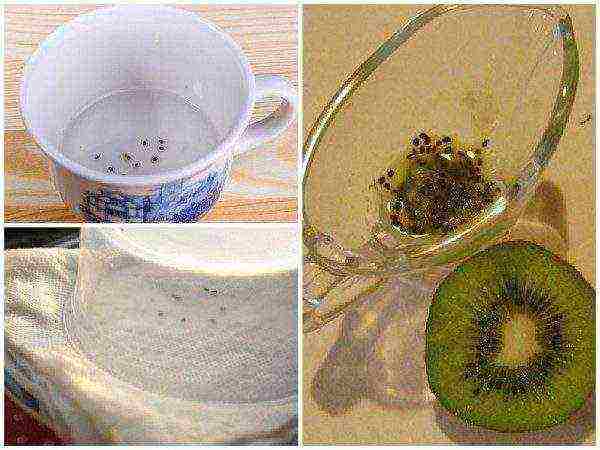
It is very important to completely separate the kiwi seeds from the pulp - its remnants can provoke the development of rot
- The seeds are laid out on a paper napkin or cotton towel to dry. After a few hours, they finally dry out, changing color from black to grayish brown.
- A small piece of cotton wool or gauze is moistened with hot water. Instead, you can use a pale pink solution of potassium permanganate (for disinfection) or any available biostimulant (to increase germination). Suitable, for example, potassium humate, Kornevin, Zircon, Heteroauxin, succinic acid, aloe juice.
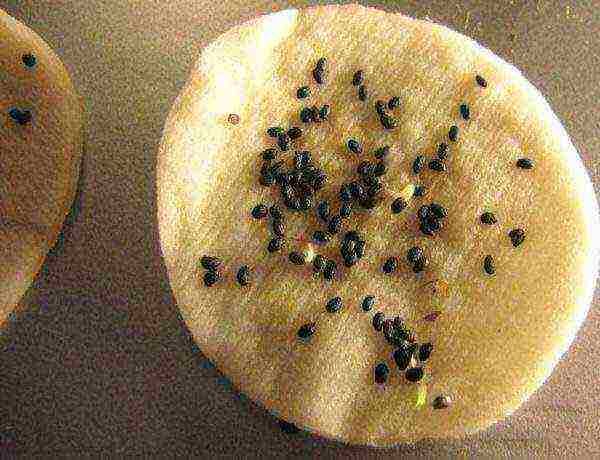
Pre-germinated kiwi seeds sprout faster
- The seeds are wrapped in damp gauze, put on a saucer, which is covered with plastic wrap. Every day at night it is removed. In the morning, the gauze is moistened again and the "shelter" is restored. After about 7-10 days, the seeds will germinate and can be planted. Another option for pre-planting preparation is stratification. The seeds are placed in the refrigerator for 2-3 weeks. Then they are kept for 10-12 days in the warmest place in the apartment.
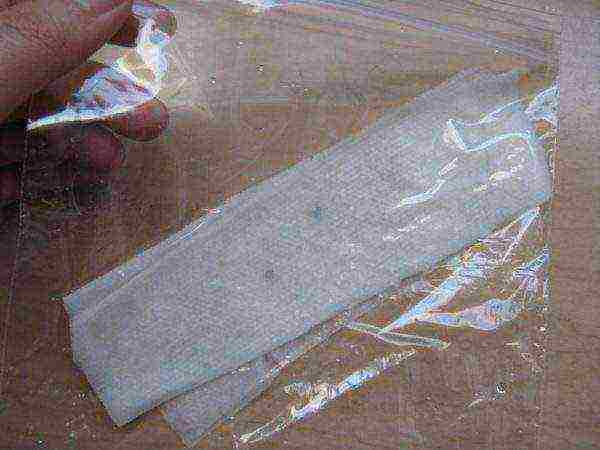
For convenience, you can use special bags with a fastener - it is easier to remove the "cover" from the gauze without risking spilling the seeds
Sometimes another method is recommended - for a week during the day, kiwi seeds are kept warm, at night - in the cold.
Preparing for landing
The root system of kiwi is quite developed, strongly expanding in width, but superficial, fibrous. Therefore, it makes no sense to acquire a deep pot, shaped like a bucket, there is no point. The best option is a container that looks like a bowl or salad bowl. A prerequisite is the presence of drainage holes. Of the materials, it is worth giving preference to natural ceramics - it allows air to pass through better, preventing moisture from stagnating.
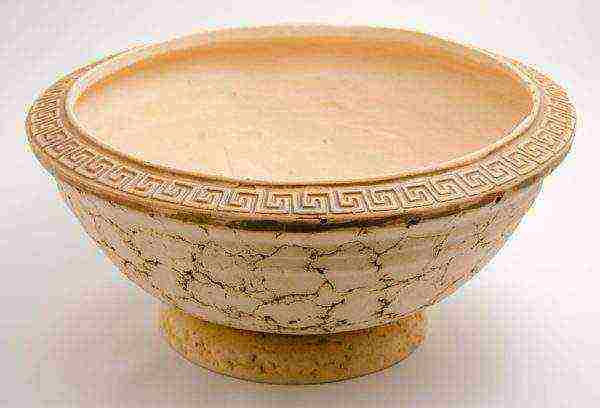
A bucket-shaped pot can greatly inhibit the growth of vines, so a wide and shallow pot is the best option so that the roots have room to unfold.
Kiwi soil prefers light and loose, but nutritious. A mixture of peat chips, coarse river sand and black soil in a ratio of 1: 2: 3 is well suited for it. You can add 8-10 g of sifted wood ash and powdered eggshells for each liter of finished substrate. Another version of the soil is vermiculite or perlite, peat and humus in approximately equal proportions. If you do not want to prepare the soil mixture yourself, you can look in specialized stores for a substrate designed for any tropical vines.
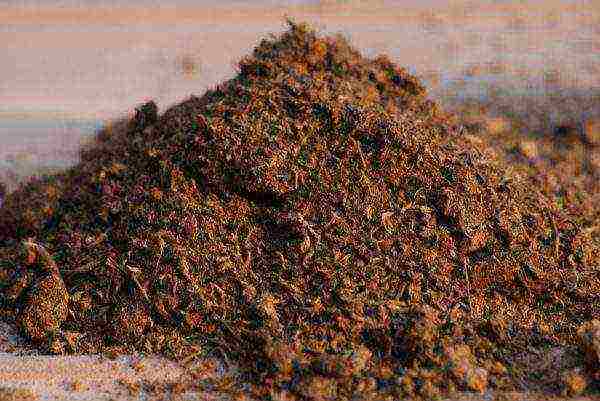
Peat is an essential component of soil for kiwi
Planting seeds in the ground
There is nothing complicated in the procedure itself. But there are also some nuances that you need to familiarize yourself with in advance.
- Expanded clay or other drainage material is poured onto the bottom of a clean pot, creating a layer at least 3-4 cm thick. Above is a disinfected substrate, filling about 2/3 of the container. It can be steamed, heat or cold to sterilize.
- The soil is well moistened by spraying from a spray bottle and leveled. When the water is absorbed, the seeds are sown as evenly as possible. Some growers recommend leaving them on the surface, others advise covering them with a thin (1–1.5 mm) layer of fine sand.
- The plantings are moderately moistened again, the pot is covered with glass or covered with plastic wrap to create a greenhouse effect. To place the container, choose the warmest place in the apartment (temperature not lower than 25–27 ° C). It is also desirable to have at least 12-14 hours of daylight hours and bottom heating. To avoid the appearance of condensation, the "greenhouse" is opened daily for 3-5 minutes for ventilation. As it dries, the soil is sprayed from a spray bottle. It should be slightly damp at all times, but not wet.
- Seedlings appear massively and quickly enough. 2-3 weeks after this planting is thinned out, getting rid of the weakest seedlings.
- When the kiwi seedlings reach a height of 10-12 cm (after 4-6 weeks), they are planted in individual containers. Such plants already have 2-3 pairs of true leaves. A suitable soil is a mixture of peat, turf and sand in approximately equal proportions. In the process of picking, you need to try to injure the roots of the plant as little as possible. They are very delicate and fragile in seedlings. At the same time, you need to take care of the support. If you stick it into the pot later, again there is a risk of damaging the roots.
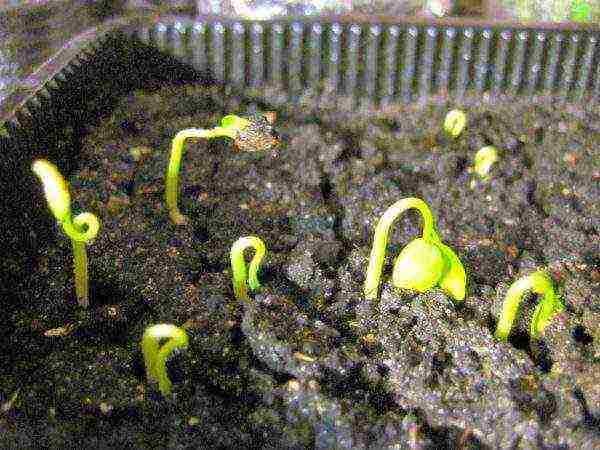
Kiwi seeds are distinguished by good germination, but then many sprouts may die, it depends on the conditions of their maintenance
Since the kiwi vine differs in its growth rate, and the purchase of pots "for growth" is not recommended for any indoor plants, young specimens will have to be transplanted quite often, every 5-6 months. For the first few weeks after the procedure, it is recommended to rearrange the plant from the windowsill, removing it where it will definitely not be exposed to direct sunlight. For adult kiwi, the heat is quite comfortable, but young vines can slow down greatly in growth.
A kiwi transplant is carried out as needed. As a rule, once every two years is sufficient. The diameter of the pot is increased by 3-5 cm.It is carried out by the transshipment method, trying to destroy the earthen lump as little as possible and injure the roots. They are very fragile in the plant.
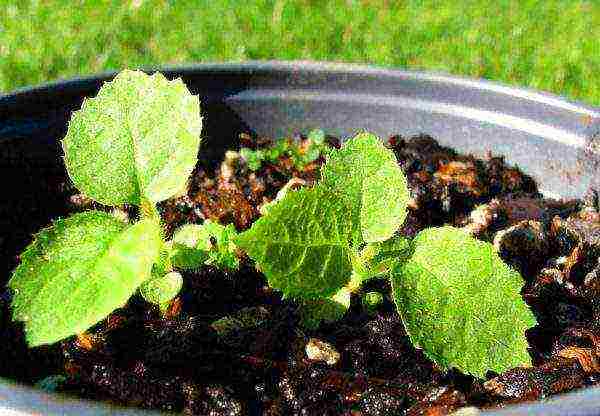
Home-grown kiwis (especially young specimens) need frequent transplanting - the vine grows fast enough
Video: collecting kiwi seeds and planting them
How to plant a kiwi stalk
Most often, kiwi plants grown from seeds at home are not used for harvesting, but as a rootstock for "cultivated" varieties. For this, only seedlings aged three years and older are suitable. You can plant kiwi in any way. The results are good in each case.
Cleavage grafting
A lignified kiwi stalk is part of an annual shoot, cut from an adult vine of a certain variety in winter. For a plant, such pruning is a mandatory procedure. Green cuttings are obtained by cutting off the tops of the shoots formed in this season in the summer.
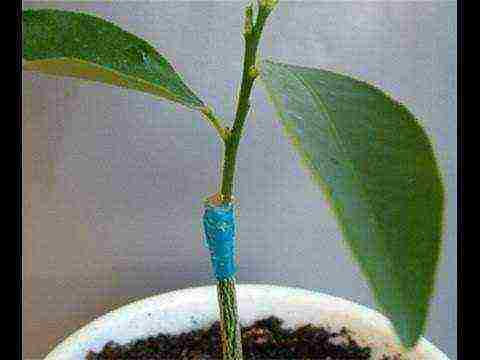
It is very important to securely fix the entire structure during the grafting process.
The optimum length of the cutting is 8–12 cm (2–3 pairs of leaves), the thickness of the shoot from which it is taken is 7–10 mm. It should be absolutely healthy, the bark should be smooth, uniform, elastic and intact. The best time of day for cutting a cutting in summer is early morning.
To obtain planting material, a sharply sharpened disinfected tool is used - scissors, a knife, a pruner. The latter option is preferable, since it minimally traumatizes the shoot tissue, the bark does not crack or crumple. The lower cut is made at an angle of approximately 45º, the upper (straight) cut is 8–10 mm above the last kidney.
The easiest way is cleft vaccination. In this case, the cuttings are harvested in the fall and buried in the snow for the winter. The procedure is carried out in mid-spring.
- The bases of the cut cuttings are placed in a container filled with water at room temperature for about a day. Their tops are covered with a damp cloth or plastic wrap. After a day, the cuttings are transferred from the water to a solution of any root formation stimulator prepared according to the instructions. After 18–20 hours, they are ready to be vaccinated.
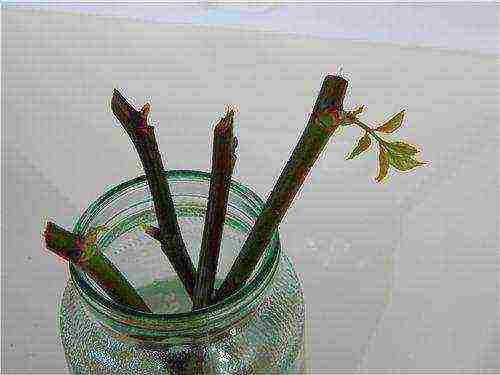
Parts of the shoots should be submerged in water about half.
- The seedling rootstock is shortened to a length of 3-5 cm, making an even horizontal cut. In the middle, perpendicularly with a scalpel or razor blade, cut a gap 2.5–3 cm deep (the so-called split).
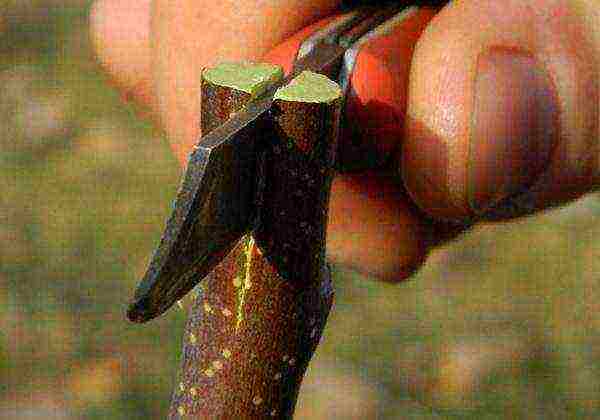
It is necessary to ensure that the split is not too wide - the stalk should enter it with some effort
- A 12–15 cm long stalk, approximately the same thickness as the rootstock shoot, is cut from the bottom on both sides at an angle, forming something like a wedge 3–3.5 cm long. It should start as close to the lower bud as possible.
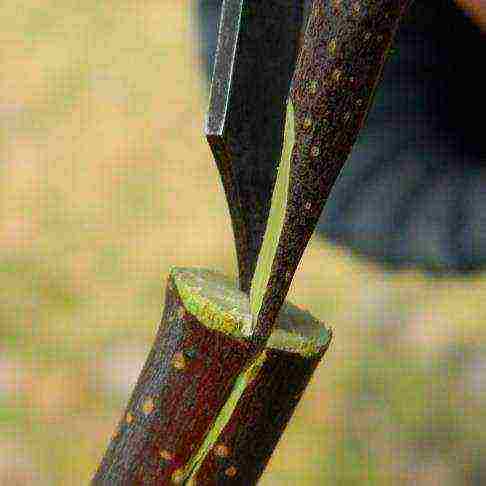
The wedge shape is necessary for the most convenient entry of the scion into the stock
- The graft is inserted into the rootstock split. Part of the cut on it should remain in the open air. The cut off part of the cuttings promotes faster accretion of the scion and rootstock.
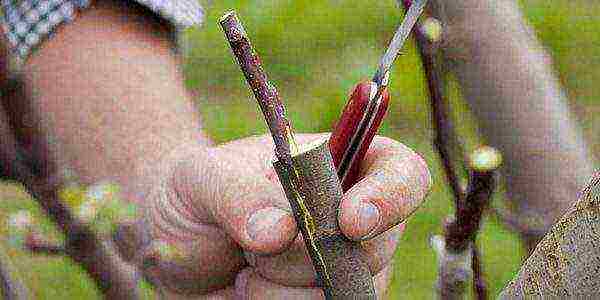
It is very important to carry out the procedure with clean hands, otherwise the cut may become infected.
- The junction of the shoots is wrapped with plastic tape in several layers. When the callus appears, the winding is removed.
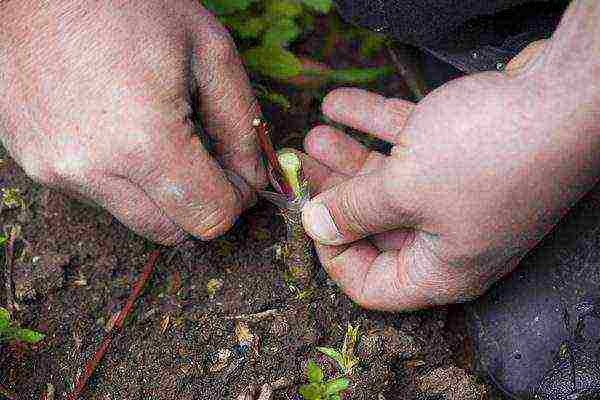
Electrical tape or cling film will help protect the junction from negative effects.
Video: how to graft a stalk correctly
Another common method is budding. This is essentially the same vaccine. The difference is that in this case, not a whole stalk is used, but only one growth bud, removed from it along with a thin layer of wood. The simplest option is budding in stock. A bud cut from a scion plant is combined with a bark-cleared area on a liana rootstock. Some growers argue that in order for the parts to grow together, a cruciform incision with a depth of 2–4 mm is generally sufficient.
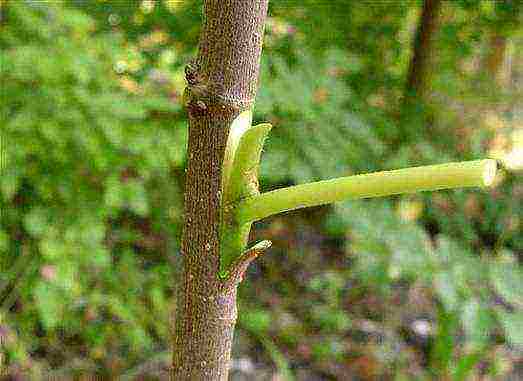
The budding procedure is fundamentally no different from vaccination
Video: budding process in stock
Pruning guidelines
Liana kiwi is distinguished by its growth rate, so pruning for it is a mandatory procedure. Such plants look much more aesthetically pleasing and neat, bear fruit more abundantly. If the growth of a vine is not limited in any way, it can stretch up to 7-10 m in length. Keeping such a plant in an apartment is completely impossible.
For seedlings that have grown to a height of 25-30 cm, pinch the top, removing 2-3 last buds. This stimulates the plant to branch more intensively. But an overabundance of green mass is harmful to the plant - all its strength goes to its nutrition, so the fruits are not tied at all or fall off long before ripening.
An adult kiwi plant at home should consist of 5-7 shoots, starting at a distance of about 45-50 cm from the base of the stem. A dense growth is constantly formed on them, which will have to be shortened throughout the growing season. It is impractical to preserve it, since only the lower 5–6 “eyes” of each one-year shoot bear fruit.
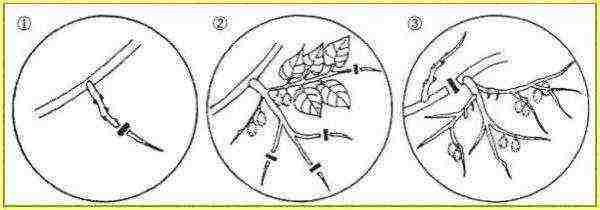
There is no point in leaving very long shoots on the kiwi vine: only the lower 5-6 buds bear fruit
Old branches are gradually removed, replacing them with replacement shoots. Usually, a kiwi needs rejuvenating pruning every 5-6 years. If carried out correctly, the productive lifespan of the vine stretches for 40-50 years.
Pruning is especially important when there are several plants close to each other. If it is not carried out, one of them may simply "strangle" the neighbors. Also, removing excess foliage and weak shoots improves air exchange in the crown, minimizing the risk of spreading diseases and pest attacks.
A different method of formation is more often used when growing vines in the open air, but at home such plants look pretty.
- An annual seedling is shortened to a height of 30 cm.
- A year later, to the point of growth, all formed lateral shoots are cut off, except for two (the so-called shoulders).
- When they reach a length of 1 m, their tops are pinched. From all the shoots formed on the "shoulders", 3-4 lateral branches are left, located at an approximately equal distance from each other. They are shortened by cutting off after the fifth or sixth bud.
- During the active growing season, all shoots on these branches and new side shoots on the "shoulders" are immediately removed.
- Having collected the harvest, the fruiting shoots are pinched so that 6-7 new leaves remain above the last berry. The branches on which there were no fruits are shortened to the fifth leaf bud.
- The branches at the age of three are pruned to the point of growth. Soon a new shoot will begin to form from it, which is pinched after five leaves have formed on it.
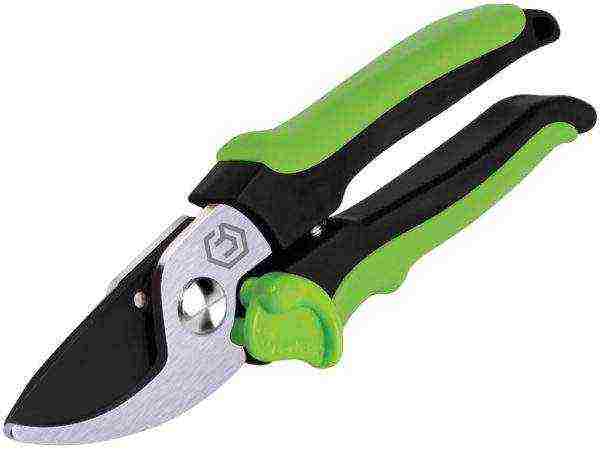
The pruner, like any other tool used to prune kiwi, must be sharpened and sanitized.
A heavily neglected or old kiwi vine can be rejuvenated by radical pruning in the spring. Unlike most indoor plants, kiwi normally reacts to the loss of a significant part of the green mass, quickly recovering and starting to grow after such "stress".
Other important nuances of caring for a vine
Those who are going to grow kiwi, first of all, should remember that this is a southern subtropical plant. This is what you need to focus on, creating an optimal microclimate for it. In the wrong conditions, the vine will most likely simply refuse to bear fruit.
Creating a suitable microclimate
The most important requirement of a vine is sufficient lighting. The pot is placed on a windowsill facing south or southwest. In winter, natural light is not enough, so you will have to use fluorescent or special phytolamps, extending the daylight hours to 12-14 hours. It is better to place them so that the light falls on the plant in a horizontal plane.
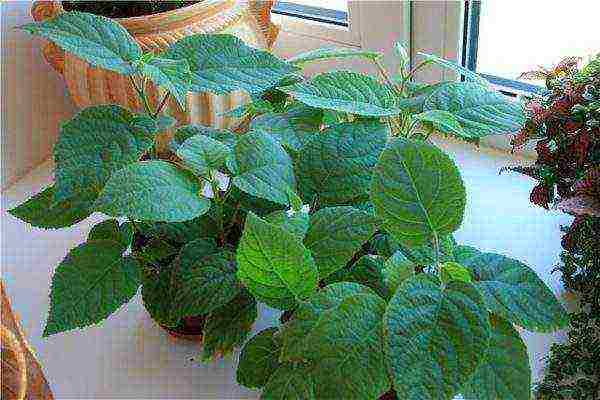
Kiwi vitally needs a lot of light, with this in mind, they select a place for the pot
At the same time, kiwi must be protected from direct sunlight during the hottest hours. They cause serious burns, especially if the vine was watered shortly before. You can apply kiwi with tulle, a paper screen, several layers of gauze.
With a shortage of light, the stems of the creepers become ugly thinner, the leaves turn pale and shrink, the gaps between them increase. Flowering and, moreover, fruiting in such conditions can not be expected.
Kiwi will most likely react negatively to any changes in the conditions of keeping. The plant especially does not like sudden temperature changes and cold drafts. Therefore, a place for him is chosen once and for all, approaching this procedure with all responsibility.
Plant care
Caring for kiwi at home is simple. Basically, it comes down to regular watering and feeding. This is enough for the vine to feel good and bear fruit.
Kiwi prefers natural organic fertilizers. It is best to alternate it with mineral fertilizers. The liana spends quite a lot of energy on the growth and formation of fruits, so fertilizing is applied every 12-15 days, from mid-March to October.
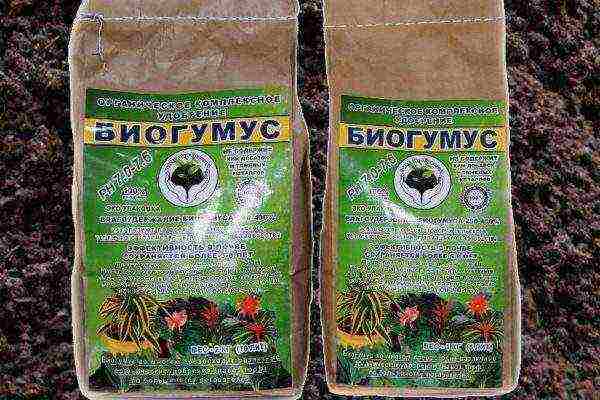
Vermicompost is an absolutely natural fertilizer
The very first top dressing is vermicompost, humus or rotted compost (nitrogen source). An annular groove is made in the pot around the plant and fertilizers are applied there. During the season, along with water, nutrients will gradually flow to the roots. Then you can alternately use a complex mineral fertilizer and infusions of nettle leaves, dandelion, wood ash, bird droppings.
Kiwi needs frequent and abundant watering, but at the same time stagnation of moisture in the pot does not tolerate categorically. To avoid this, 30-40 minutes after the procedure, it will be necessary to drain the excess liquid from the pan. Watering is carried out at least once every 3-4 days. At the same time, the earthen lump is moistened as evenly as possible. It is best to use a watering can with a splitter attachment for this.

A watering can with a splitter helps to evenly wet the earthen ball in the kiwi pot
In extreme heat, in addition to watering, it is advisable to spray the liana from a finely dispersed spray bottle. In both cases, water is used warmed up to room temperature. You can also use a dedicated humidifier. Or just place pots with cool water next to the kiwi, organize the liana "company" from other indoor plants, place wet expanded clay, sphagnum moss in the pot tray.
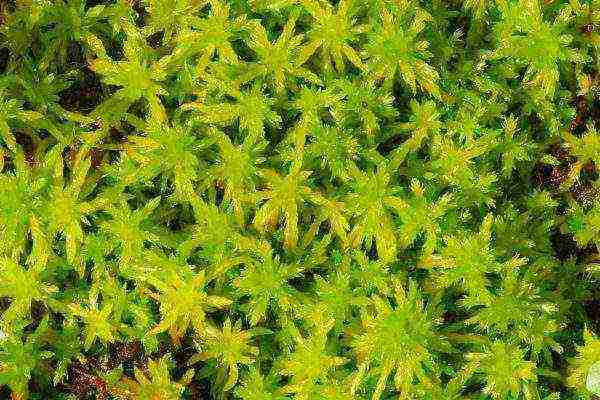
Sphagnum moss retains moisture well, which is very useful for indoor plants in the heat
For the winter, the vine sheds its leaves, this is a natural process for it. As soon as this has happened, feeding is stopped altogether, and the number of waterings is reduced to once every 10–12 days. During hibernation, it is advisable to transfer the plant to a cool, light room, where the temperature is maintained at 12-16 ° C.
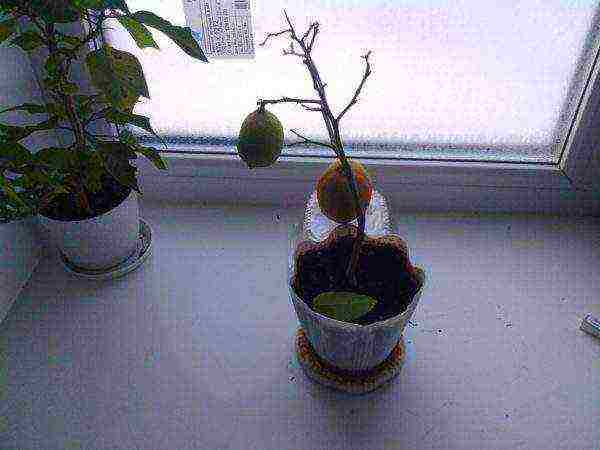
Kiwi, like most fruiting tropical plants (lemons, pomegranates, pineapples) at home for the winter sheds leaves
Diseases and pests threatening kiwi
Like any actinidia, kiwi rarely suffers from diseases and pests. This also applies to home grown specimens. But at the same time, you should not neglect the regular inspection of the vine. The earlier the problem is noticed, the easier it is to deal with it.
Often, the florist himself is to blame for the deterioration of the appearance and condition of the kiwi. The mistakes made by him in the care provoke problems with the plant.
Table: how kiwi reacts to improper care
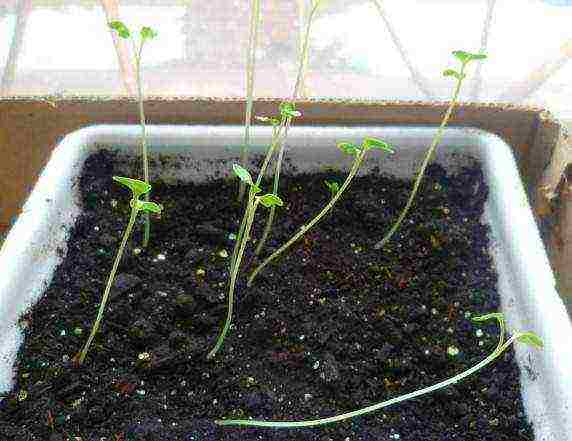
Due to the lack of light, the kiwi vine is ugly stretched out - this applies to both adult plants and very young seedlings
In addition to the so-called non-infectious diseases, the symptoms of which most often disappear when the microclimate is normalized and the correct feeding is carried out, kiwi can also suffer from fungal diseases. Most often, with waterlogging, various types of rot develop. Also, the plant is not ignored by such "universal" pests of indoor plants as aphids and scale insects. They are distinguished by their rare "omnivorousness".
Table: diseases and pests that can threaten kiwi when grown at home
Photo gallery: diseases and pests dangerous for kiwi
Reviews about growing kiwi
Kiwi or Chinese actinidia is another culture successfully "domesticated" by amateur growers. If you create optimal or close conditions for it, this vine feels good in captivity, delighting the owner with its growth rate and regular fruiting. It rarely suffers from diseases and pests - this is an undoubted advantage of the plant.
27 years old, higher education in law, broad outlook and interest in a variety of topics.
Almost all growers seeking to improve their own skills at one point decide to grow fruit-bearing crops, such as citrus fruits, coffee or vines. And many are wondering if it is possible to start growing kiwi at home. In reality, this is quite possible, but certain requirements must be observed in the process.
How kiwi appeared: an interesting fact
Kiwi is also known as Chinese gooseberry. And in order for this culture to begin to bear fruit, you need to simultaneously grow two varieties of plants - male (required for pollination) and female. If you plan to grow with seeds, then be prepared to wait for the flowering period, because that's when you can determine the gender of the vine. In most cases, kiwi blooms in the sixth year of life.
We grow kiwi at home
Basic requirements for growing
So, the growing process is not difficult, but you will have to show accuracy, care and patience.
How kiwi is grown
You can grow kiwi:
- cuttings;
- seeds;
- accessory buds of the roots.
All methods have their own nuances, advantages and disadvantages, which we will get acquainted with a little later. However, there are a number of general rules that apply to kiwi breeding.
Kiwi is a distant relative of grapes, and therefore uses a similar cultivation technology here. The described culture is warm and light-requiring, therefore it must be located in a well-lit place (preferably without drafts). It should be remembered that the direct rays of the sun can lead to burns of foliage, therefore, the light should fall from the side. An even better option is vertically directed artificial lighting.
Kiwi from seed
In the process of development, the pots should be periodically scrolled clockwise (every two weeks, 10-15 °). This will provide the plants with a straight silhouette, and the crown will turn out to be dense and uniform.
Note! There are many varieties of kiwi, but, characteristically, almost all of them are suitable for growing at home.
Kiwi varieties
Yellow kiwi
It should also be remembered that kiwi is a dioecious crop, and therefore one male and at least two or three female plants are required for normal fruiting. If kiwi is grown from seed, then about 80 percent of the seedlings are male, so there should be as many of them as possible.
Now let's look directly at the workflow.
Kiwi - growing at home
It is better to start growing kiwi in early spring, because then the highest germination of seeds is observed. This is a very important point, so do not delay sowing. Also consider the fact that kiwi naturally grows in regions with long and warm summers, so the conditions for the plant should be as comfortable as possible.
Traditionally, the process begins with the preparation of everything needed.
If you really want to grow kiwi at home, make sure you have enough free space.
Stage one. We prepare everything you need
To grow vines, you must prepare:
- one ripe kiwi fruit;
- neutral or slightly acidic soil intended for citrus crops (you can purchase it at any specialized store);
Citrus primer
- thoroughly cleaned river sand;
- mini greenhouse (you can use PET film instead);
Mini greenhouse
- fine-fraction expanded clay - it will be used for drainage.
"Shop" soil can be replaced with self-prepared soil mixture, consisting of peat, sand and black soil (in equal proportions). By the way, when you dive seedlings into pots, this soil mixture will also work well, only there should be less peat in it.
Stage two. Preparing the seeds
Cut the fruit in half
Take a ripe fruit and cut it in half. You can eat one part, and extract about 20 grains from the other. Peel the pulp from the grains (otherwise they will rot in the ground), but do it carefully, do not damage the shell. To simplify the procedure, you can throw the seeds into water, mix them well and leave to settle for a while. Repeat the process two to three times to minimize the risk of seeds rotting.
Then spread the seeds on a napkin and dry for four hours.
Collection of kiwi seeds
Stage three. Germinating seeds
Step one. Place a piece of cotton wool in a saucer and pour boiling water over it. There should be enough water so that the cotton wool is saturated with it, but the saucer should not be poured.
Step two. Cover the saucer with a piece of plastic and place in the lightest spot in your home.
Step three. Remove the film every evening, and return it the next morning, adding a small amount of water (the cotton wool should be damp all the time).
Soak the seeds
Step four. After about a week, when the first shoots appear (in the form of thin white roots), you should plant the seeds in the soil.
Germinating seeds
Stage four. We transplant seeds into soil
As for the soil, then it should be the same as indicated in one of the previous paragraphs. Pour it into prepared containers or pots (the bottom should be previously covered with expanded clay drainage layer) and make small holes on the surface (the depth should not exceed one centimeter). Place the seeds in the holes, sprinkle lightly with soil, but do not tamp.
Cover the containers with foil or glass and place in a warm place. Alternatively, you can put them in a mini greenhouse. Thereafter, water the ground daily. It should not dry out, otherwise the sprouts will simply die. When watering, you can use a spray bottle, or you can place the pots in a pan and pour water there.
Seed-grown kiwi sprouts
Note! When the first shoots are formed, start accustoming to fresh air. To do this, remove the glass / film daily, increasing the ventilation time over time.
Stage five. Making a pick
About four weeks after planting the seeds, when there are several true leaves on the seedlings, perform a pick, that is, transplant the plants into individual pots. The soil at this stage, as noted earlier, should already contain less peat, while more sod soil can be used. At the same time, act very carefully, because the root system of vines is extremely delicate and located on the surface, which means that it is easy to damage it.
Kiwi after a dive
What is a transplant for? The fact is that this plant has rather wide leaves, which, as they develop, will shade each other.
Sprouts with large leaves
How to grow kiwi at home
Stage six. Further care
To ensure that conditions are as close to natural as possible, you must adhere to a number of rules. Let's consider these rules in more detail.
Growing kiwi from seeds
Table. Key Requirements
| Humidity | The earth, as we have already found out, should not dry out, so take care of uniform watering.It is preferable to use a spray bottle rather than a watering can - this will moisten the entire soil surface at once, and the plants will not be damaged. It is also advisable to count the number of sprinkler clicks so that each time the amount of moisture introduced is the same. |
| Pinching | Pinch the upper part of the vine from time to time - this will stimulate the formation of lateral processes, and the plant itself will turn out to be stronger. |
| Lighting | Kiwi needs a long day of light, which means, if possible, place containers on windowsills on the south side. If this is not enough, extend the lighting time artificially with a fluorescent lamp. In winter, the lighting should be horizontal. |
| Feeding | Use organic fertilizer - compost or vermicompost. Apply it every year, digging a small trench around each plant beforehand. In this case, when watering, the top dressing will gradually flow to the root system, so that the vines will grow healthy. |
Note! In the summer, additionally apply a complex type of mineral fertilizer. Do this about once every seven to ten days.
Features of vegetative reproduction of kiwi
Seedlings of this culture are grown using the same technology as described above. The only difference is that the seed must be sown in January. Two years later, a kiwi of one or another variety is grafted onto a seedling, which by that time will grow up and get stronger.
Kiwi seedlings
Seedlings before planting in soil
Grafting can be done in the same ways that are used for other plants; in particular, these are:
- budding;
- cleavage with a green handle;
- a similar process, but with a lignified cuttings.
The vine can then be planted in open soil. If the kiwi will be grown indoors, as in our case, then you should take care of a container of sufficient depth (the roots should have a lot of room for further growth).
You can also grow seedlings from rooted cuttings. The disadvantage of this method is considered to be low germination in indoor growing - there are either few or no plants at all. As for further care, it is the same as when growing by seeds. When the cutting / seedling enters a period of active growth, it will no longer be afraid of low temperatures and can easily adapt to any conditions.
Planted kiwi seedling
How to get a big harvest?
Liana needs to be placed correctly. It needs a lot of space, so it is better to grow it on an insulated balcony. Also organize a support along which the plant will climb, or make a beautiful and original balcony frame out of it. The length of one liana, by the way, can reach seven meters.
Kiwi on the loggia
Note! Pollination should be taken care of to obtain fruit. In natural conditions, insects are engaged in this, in our case, you must do everything with your own hands.
If there are too many male vines, you can plant "eyes" on them from female vines, which will allow you to get fruit. Ideally, five or six females should fall on a male plant, and if the proportions are not correct, then it is better to vaccinate. The “eyes” take root well, thanks to which the yield will increase significantly.
Video - Kiwi inoculation
Also, periodically inspect the kiwi leaves, and for two reasons at once.
- This will allow you to detect the fungus in time and clean the leaves.
- Liana can be "infected" by various pests from neighboring plants, so in addition to inspection, try to place kiwi as far away from them as possible.
With the onset of autumn, cut off old shoots: those branches that have already borne fruit are recommended to be removed. This will free up space for new shoots, and the vine itself will not age and will bear fruit for many years.
Kiwi harvest
If the vine grows on the balcony, then in winter you will have to additionally protect it from frost. To do this, remove the shoots after scrapping and wrap them up.When spring comes, they will sprout more young shoots.
And in conclusion - one more useful advice. For some reason, cats love the branches and foliage of kiwi, so if you have such a pet, then take care of protecting the plant - you can, for example, enclose it with a net. Otherwise, the kiwi may die.
How to wean a cat from walking on flowers? Ordinary toothpicks will help you.
Seedlings in a cage
Video - Features of growing kiwi
 Is it possible to grow a kiwi tree indoors? Experienced gardeners say yes! Moreover, even a beginner can get a house plant on the windowsill that will bear fruit. Its cultivation is quite painstaking, but many people call the process fascinating for this. Description and photo instructions will help you understand the algorithm.
Is it possible to grow a kiwi tree indoors? Experienced gardeners say yes! Moreover, even a beginner can get a house plant on the windowsill that will bear fruit. Its cultivation is quite painstaking, but many people call the process fascinating for this. Description and photo instructions will help you understand the algorithm.
Home growing kiwi: what you need to know before planting
In the wild, the Chinese gooseberry kiwi, like apples or pears, is a small 30-gram fruit. The habitual large fleshy fruits from 100 g and heavier were received by breeders of New Zealand. Today fruits with a refreshing delicate taste are popular all over the world. In addition, they are very useful and are used in cosmetology, as well as for the prevention of a large number of diseases.
Kiwi grows on beautiful, tree-like vines that resemble a vine. At home, the fruit tree is grown from seeds. Key points to consider before boarding:
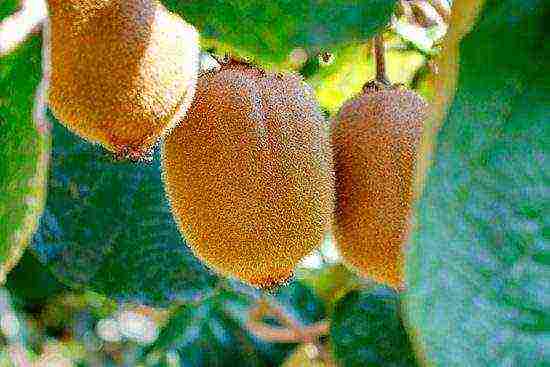
Kiwi needs plenty of sunlight
- Kiwi is a dioecious crop. To grow fruit at home, you need at least two plants. You can only determine which specimen is female and which is male only during flowering. Therefore, it is better to plant several vines at once.
- Under optimal conditions of maintenance and care, you will receive the first flowering and fruits no earlier than after 4-6 seasons.
- Any varieties are suitable for growing in a room setting.
- The plant needs about the same conditions as the grapes. For example, in the abundance of sunlight.
If your home does not have south-facing or adjacent windows, a normally developed plant may not come out.
Attention! There are special frost-resistant varieties that are suitable for growing in the open field of the middle lane. The conditions and care in this case are similar to those in the room. Only for the winter should the plant be wrapped. It may take up to 10 years to wait for fruits from such vines.
Planting kiwi: technology and features
Gardeners recommend starting all kiwi planting procedures in early spring. This time is considered optimal to obtain maximum germination. Kiwi seed is not difficult to find. Buy a fully ripe fruit that is soft and crumbly. Without peeling, cut it in half.
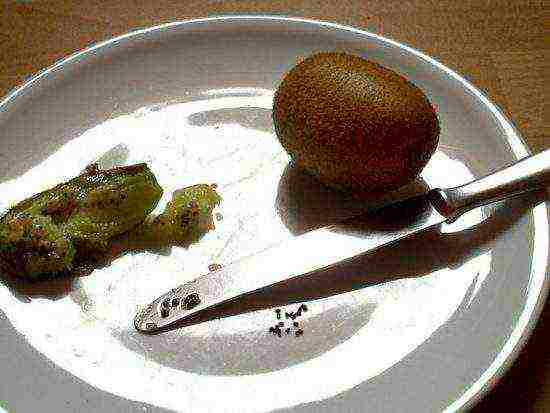
Take seeds from ripe juicy fruit
Then proceed like this:
- remove about 20 seeds, carefully remove the pulp from them;
- wrap the material in gauze and rinse several times with tap water;
- Spread the seeds on a saucer and leave to dry for a couple of hours under normal room conditions.
Attention! At the stage of harvesting seeds, you need to completely get rid of the pulp. Otherwise, the material will start to rot.
The next step is to germinate the seeds to speed up germination:
- Place cotton wool, moderately soaked in hot water, on a saucer. Place the seed on it.
- Place the plate on a well-lit windowsill and cover with plastic wrap. The mini-greenhouse should be opened at night. But make sure that there are no drafts at this time. In the morning, wet the cotton wool again with hot water and stretch the film.
Under these conditions, the seeds should form seedlings in 7-10 days. Maintain the regimen until you see delicate white roots. Now the germinated seeds should be transplanted into the soil:
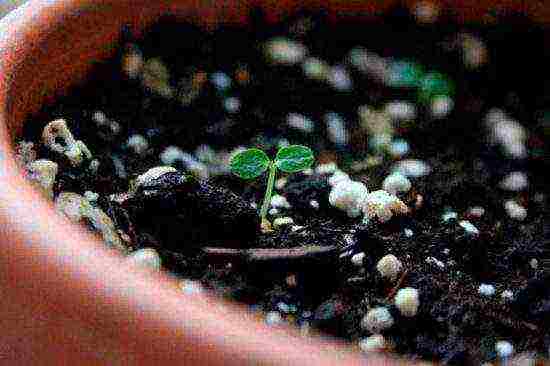
Kiwi sprout
- Mix equal parts humus, peat, turf and sand.
- Fill small pots with soil. In each, right on the surface, put a few seeds. Sprinkle them on top with a thin layer of soil. You can't ram the ground.
- Spray the planting daily, keeping the topsoil moist. Use only a spray bottle, simple watering cannot be carried out.
Advice. Moistening the earthy coma during this and subsequent stages of growing is extremely important for the plants. Therefore, other methods are suitable for these purposes. For example, installing a mini greenhouse with half plastic bottles above each pot. However, an excessive amount of water for the root system of the plant will be detrimental.
Growing kiwi: caring for young plants
To take care of the fruit tree efficiently, bring the growing conditions as close as possible to their native, natural ones. Kiwi grows in a climate of long, warm and humid summers. In addition to low humidity or an excess of water, the plant does not like:
- cool climate, temperatures below +20 ° C;
- a sharp drop in temperature even in warm weather;
- wind;
- lack of sunlight.
Advice. If these features are taken into account, you can take the plant outside in summer, and at other times of the year - on a warmed loggia or balcony.
Other nuances of kiwi care:
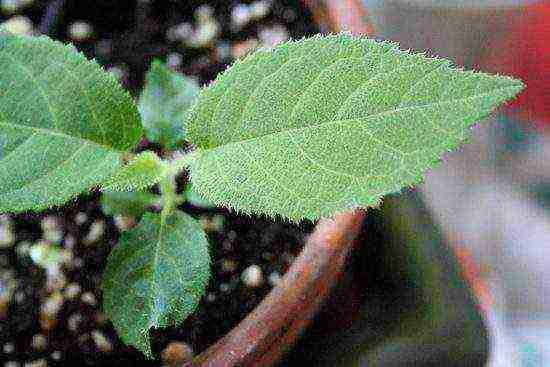
Fertilize your kiwi fruit regularly
- The key to the health and beauty of the tree is feeding with organic fertilizers: vermicompost or compost. The mixture is applied in the spring, no more than 2-3 times. You can add the entire composition of fertilizers and one-time, dry, in a trench dug around the stem. In the process of watering, the substances will gradually flow to the roots.
- In summer, gardeners recommend fertilizing kiwi with mineral complexes. Frequency - 3-4 times a month.
- Pinching the top from time to time will help to strengthen and make the vine more branched.
- A month after rooting in the ground, the plant will need a new transplant.
- Each plant needs a separate pot. It is important that wide leaves do not block the access of light to each other.
- Indoor conditions will not limit the growth of vines. An adult plant can grow up to 7 m in length. For vines, you need a support (for example, trellises), along which the kiwi will climb to the ceiling.
How to get a kiwi harvest at home
The optimal ratio of male and female plants for a good harvest is 1 to 5-6. It is very likely that by blooming you will find that this is not the case. Often there will be more male specimens than necessary. In this case, grafting of female twigs-eyes on their stems is effective.
The gardener will have to pollinate the plants on his own. Transfer pollen from male flowers to female flowers with clean and disinfected tweezers.
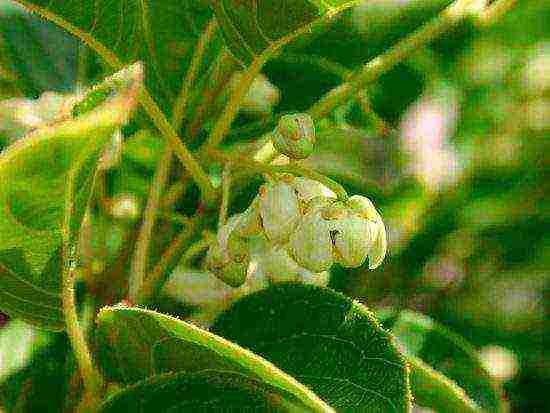
Flowering kiwi
To prevent the plant from degenerating, remove old branches in the fall, especially if the shoot has already borne fruit. This will make room for young vines and keep fruiting at the same level.
Attention! Kiwi is not very resistant to pests and diseases of indoor flowers. Keep it away from other plants. In cases of infection, use standard methods of control and prevention of a specific ailment.
Kiwi is surprisingly easy to grow in your home. Attentive owners will be able to enjoy the exotic taste from their own windowsill.
Growing kiwi at home: video
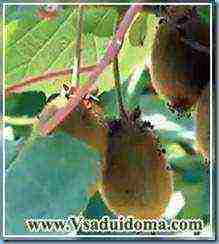 Growing exotic fruits on your own not in hot countries, but also in European latitudes, and most importantly, it is quite possible to collect rich harvests. He grows kiwi in his garden
Growing exotic fruits on your own not in hot countries, but also in European latitudes, and most importantly, it is quite possible to collect rich harvests. He grows kiwi in his garden
The 90s were marked by discoveries in all spheres of life. Gardening was not deprived of novelties: exotic, previously unseen kiwi fruits appeared on the shelves of shops and markets. I, then still a student of the Faculty of Biology, was very interested in this miracle fruit, and I began to study its origin.
It turned out that the pioneer of the plant was a New Zealand breeder, and kiwi does not occur in nature in the wild at all.
The scientist bred his variety from wild Far Eastern actinidia. Accordingly, I had a hypothesis that initially this plant is frost-resistant, which means there is a chance to return a property that was lost in the course of New Zealand breeding, so valuable for our climatic zone.
The first thing to do was to sow as many seeds as possible. After sowing hundreds of thousands of them, I exposed the seeds to various factors that enhance the natural property of plants to mutate (mutogenesis).
This was followed by days of selection and expectations that some of them would show exactly the quality that was so necessary - frost resistance.
In such a case, it remains to pay tribute to Fortune, and in the end the victorious seedling was found.
By the 5th year, this seedling had already wintered in the open field and bloomed for the first time! This could already be called a grandiose victory. Plus, the plant turned out to be monoecious, that is, a male pollinator was not required for the fruiting process.
I carried out the reproduction process in a vegetative way: I cuttings, as they usually do with grapes.
Further, day after day, a mother plantation was created, which wintered and bore fruit in the open ground of the city of Uzhgorod without any insulation. Thus, a variety arose, which I later called the Kiwi variety Karpat Stratona, a variant of "Valentine". This variety is tested at frost temperatures of -25-28 ° C. The plants were never insulated, and no cold damage was observed.
The plant is a liana bush, like all the other varieties of kiwi and actinidia that exist in the world.
Like any other vine, the kiwi needs support. It can be a trellis, a canopy, etc. The main requirement is 6 m2 of open surface of the bush, otherwise plants with a habit of less than 6 m2 are unsuitable for flowering.
The growth rate is amazing: already in the first growing season (spring - autumn) the seedling grew from 5-20 cm to 2.5-3 m! The idea came up to use the style of pruning grapes - short.
However, with this treatment, kiwi, which previously bore fruit, stopped this process for two years, until the restoration of the lost size of the bush. What are the specifics of pruning and pinching kiwi?
Separately, it is worth mentioning various kinds of manipulations that we are used to performing on plants in the early spring period. Any intervention in the development of the kiwi bush is strictly contraindicated in early spring.
This is explained by the fact that kiwi is characterized by active sap flow precisely at the beginning of spring. If you start pruning or pinching during this period, you will notice that the bush is flowing. Juice will begin to actively flow out of the cut areas, and this leads to the so-called "Dehydration" (if this concept can be applied in gardening), as a result, significant parts of the plant die.
So, any kind of manipulation of the formation of a bush can be carried out at the end of the process of active sap flow, that is, after the appearance of the first leaves and until the end of summer.
How soon after planting a kiwi to wait for the fruit to appear?
Under favorable conditions for development and growth, kiwi begins to bloom and bear fruit as early as 3-4 years after planting. The flowers are large, 4-5 cm in diameter, 6-petaled, bright white, and later cream in color. They have well-developed anthers, which naturally attracts pollinators (bees, bumblebees, etc.). It may be interesting for beekeepers to know that kiwi pollen collected by insects is snow-white in color.
Who knows, maybe very soon on store shelves you will buy not lime, acacia or meadow honey, but "kiv" honey?
The flowering period falls at the end of May and lasts 7-10 days, after which green ovaries form, which actively grow until ripening.
The period of technical maturity of the fruit is rather long, usually beginning at the end of September. Long-term technical maturity, as well as the fact that the fruits are firmly attached to the vines, without crumbling, allows harvesting without haste, in a long time.
Kiwis can be stored well for up to 5 months, provided that the fruits are not quite ripe, that is, when pressed, they are not soft. Long-term storage should be carried out in cold storage facilities with a constant temperature of 0-6 ° C.
See also: Growing kiwi fruit - planting methods, care and beneficial properties
As I already said, the kiwi propagation process is carried out in a vegetative way, both from woody plants and from green shoots. I plant the cuttings in peat containers.
This ensures the safety of further planting in open ground, protects against any damage.
The soil should preferably have a slightly acidic or neutral reaction. Therefore, I recommend not to use various kinds of deoxidizers, such as lime, ash, etc.
If your site is characterized by heavy clay soil, I advise you to reclaim those zones where the root system of the plant will develop in the future before planting.
For these purposes, you can use sand, deciduous humus, sawdust.
Does the kiwi need extra watering?
In the absence of sufficient natural precipitation, the plant requires abundant watering. Kiwi just shows a dependence on the amount of water, which is uncharacteristic, for example, for grapes. This is explained by the fact that the root system of the kiwi is superficial.
The bulk of the roots lies 8 thicker than the soil to a depth of 40-50 cm. It also follows from this that kiwi must not be dug in. But it is recommended to mulch or sod. For this, deciduous humus or sawdust can be used.
See also: Growing kiwi - grafting vines
Fertilizers for kiwi. Pest control
I have never applied mineral fertilizers. The only thing that I practice is fertilization with deciduous humus.
Significant damage by pests in my practice was not observed, which is why the fruits can be confidently called environmentally friendly, because I never had to use pesticides. It is not worth emphasizing that this is an absolute plus for any gardener - both in terms of the naturalness of the crop and relatively significant savings in cultivation.
In the case of kiwi planting in large areas, I recommend using the 3 × 3 scheme, in the form of a T-shaped trellis. You can choose the height that is comfortable for yourself, depending on the method of collection - manually or using technology. It is also very important to anticipate the aforementioned dependence on irrigation before planting a plantation. An irrigation system should be created - continuous or drip.
Subject to all conditions, starting from the 5th year after planting, the yield from each trellis bush should not be less than 25 kg. And the weight of the fruit itself under the most favorable conditions can reach 110 g / piece.
In your opinion, does kiwi have a chance to take root on the plots of Ukrainian gardeners?
Home and industrial cultivation of kiwi has good prospects. The reason for this will be not only the relatively high cost of fruits 8 for sale, but also the very value of this fruit-berry. After all, kiwi is a storehouse of vitamins, minerals and a number of biologically active substances.
The very process of growing kiwi, I assure you, is simple!
I am firmly convinced that the mass cultivation of kiwi is not far off, as well as the conquest of all our supermarkets and markets with this once New Zealand, and today already domestic fruit.
On a note:
Not only people, but also cats are not averse to eating kiwi. Moreover, animals are attracted not by fruits, but by shoots and roots of plants. Protect the seedling from animal access for the first two years.
The name "kiwi" comes from the kiwi bird. It seemed to the New Zealand scientist, the creator of the variety, that the fruit is very similar to the feathered pride of New Zealand.
Kiwi's benefit
Kiwi is an exclusively dietary product, rich in vitamins, microelements and fiber. The fruit is 84% water, 1% is fats and proteins, and 10% is slow carbohydrates. Kiwi is a very low-calorie fruit, only 48 kcal / 100 g.
Kiwi contains more vitamin C than citrus fruits. The fruit contains vitamin E, which is usually lacking in low-calorie diets, as nuts are a typical source of vitamin E.
In the flu opra, all the beneficial properties of kiwi are manifested most fully - after all, it is an excellent stimulant of immunity, and what is important is natural!
Kiwi recipe
Kiwi and gooseberry jam
Peel the kiwi and cut into thin slices. Peel the gooseberries from the stalks and inflorescences. Grate the lemon zest, squeeze the juice out of it. Beat the gooseberries in a blender with lemon juice. Mix with sugar, kiwi and zest. Put everything in a saucepan and bring to a boil, stirring continuously, until the mass is halved in volume. Then drink in sterilized jars and close the lids.
note
The uniqueness of kiwi lies in the fact that the vitamins contained in the fruit are not destroyed during heat treatment due to the high acidity of the fruit pulp. This means that kiwi canning is not a waste of time, but a real storage of vitamins.
G.V. told about his experience in growing kiwi. Straton (the author has a website where you can buy kiwi seedlings: his own selection)
Below are other entries on the topic "Cottage and garden - do it yourself"
Is it possible to grow kiwi at home: Is it possible to grow kiwi in ... Growing kiwi - grafting vines: Kiwi - grafting male and ... Growing kiwi at home: Kiwi (Chinese liana) - how ... Growing actinidia (photo) where to start ?: Actinidia for beginners We want to plant actinidia, ... Actinidia plant (photo) planting and care, what to cook: Growing actinidia in the open field ... Kumquat (photo) - planting and care at home: How to grow kumquat at home ... Actinidia (kiwi): planting and Care: Caring for Actinidia In my garden ...
Subscribe to updates in our groups.
Let's be friends!


